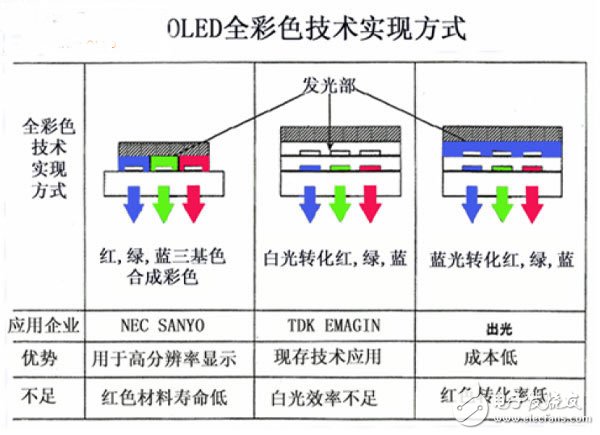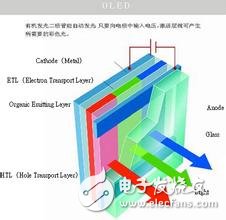OLED technology itself is just a kind of illuminating technology, so it is a large-scale display application such as TV. It requires not only high-density matrix-based driving technology, but also full-color technology: full-color display is an important factor to verify whether the display is competitive in the market. Mark, so many full-colorization techniques are also applied to OLED displays. There are usually three types of panel types: RGB pixel independent illumination, color conversion (ColorConversion) and color filter (ColorFilter).
RGB pixel independent illumination The use of luminescent materials for independent illumination is currently the most widely used color mode. It uses a precise metal shadow mask and CCD pixel alignment technology. First, it prepares the red, green and blue primary color illuminating centers, and then adjusts the color mixing ratio of the three color combinations to produce true color, so that the three-color OLED components are independently illuminated. One pixel. The key to this technology is to improve the color purity and luminous efficiency of the luminescent material, while the metal shadow mask etching technology is also crucial.

At present, the organic small molecule luminescent material AlQ3 is a good green light luminescence small fraction of the material, its green color purity, luminous efficiency and stability are very good. However, the luminous efficiency and lifetime of the best red and blue light emitting small molecule materials of OLED are not satisfactory. The biggest bottleneck faced by organic small molecule luminescent materials is the purity, efficiency and longevity of red and blue materials.
The advantage of the polymer luminescent material is that it can be adjusted by chemical modification. It has been obtained from blue to green to red in various colors covering the entire visible range, but its lifetime is only one tenth of that of small molecule luminescent materials. Therefore, for high molecular polymers, the luminous efficiency and lifetime of the luminescent materials need to be improved.
In the ternary color RGB pixel independent illumination technology, it can be divided into two horizontal color pixel distribution modes: horizontal distribution and vertical distribution. Although the vertical mode requires less process fineness, the process and material consumption are complicated, and the underlying light source has a higher projection loss. The horizontal pixel allocation scheme has better optical effects, but the precision of one process is higher!

The light color conversion is a combination of a blue OLED and a light color conversion film array. First, a device for emitting a blue light OLED is prepared, and then a blue light excitation color conversion material is used to obtain red light and green light to obtain full color. The key to this technology is to improve the color purity and efficiency of the light color conversion material. This technology does not require a metal shadow mask alignment technology, and only needs to evaporate blue OLED components, which is one of the potential full-color technologies for large-size full-color OLED displays in the future. However, its disadvantage is that the light color conversion material easily absorbs blue light in the environment, resulting in a decrease in image contrast, and the light guide also causes a problem of reduced picture quality. The key to the success of this technology is the breakthrough in the development of light-colored conversion materials – unfortunately, the development of such materials has continued in recent years, and some companies have begun to abandon this color scheme.
The color filter film technology utilizes a white light OLED combined with a color filter film to first prepare a device for emitting a white light OLED, and then obtains three primary colors through a color filter film, and then combines the three primary colors to realize color display. The key to this technology is to obtain high efficiency and high purity white light. Its production process does not require metal shadow mask alignment technology, and can adopt the color filter film making technology of mature liquid crystal display LCD. Therefore, it is one of the potential full-colorization technologies for large-size full-color OLED displays in the future, but this technology can cause up to two-thirds of the light loss caused by the color filter film. At present, Japan's TDK Corporation, the United States Kodak Company, and LG Corporation use this method to make OLED displays.
RGB pixels are independently illuminated, and color filter films are used to manufacture OLED display full-colorization technologies, each of which has advantages and disadvantages, but are very mature and can be applied on a large scale. However, light color conversion is also facing the bottleneck in the development of light color conversion materials. According to the characteristics of the process structure and organic materials, the future three primary color pixel independent illumination is eager to become the main technology of high-end OLED display, and the white color filter film technology is suitable for the preparation of lower-priced OLED display products.
Projector Lamp,Projector Light Bulb,Projector Lamp Replacement,Projector Bulb Replacement
Shenzhen Happybate Trading Co.,LTD , https://www.happybateprojector.com